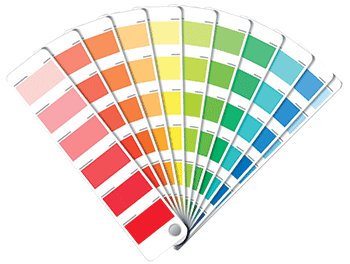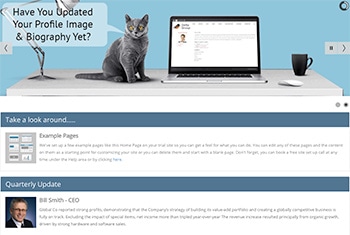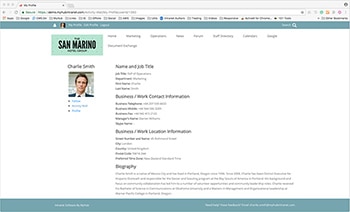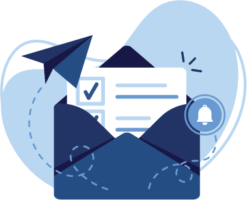Organizations with high levels of engaged employees are more productive and profitable, period. That’s the key message from recent research by Gallup. In fact, according to Gallup engaged organizations show much lower rates of employee turnover and absenteeism, as well as 17 percent higher productivity and 21 percent greater profitability than their less engaged counterparts. These statistics make compelling reading. And so, if you haven’t yet addressed the issue of employee engagement in your organization, then you can’t afford to ignore it for much longer. The company intranet is the perfect tool for enhancing employee engagement. And in this article, we share some tips on how a thoughtful intranet design can help to engage staff and improve all-round productivity and profitability.
1. Keep It Simple
A clean, uncluttered design is the essential starting point. Don’t make the mistake of cramming every feature and tool on the home page. All that will do is create a site that frustrates and overwhelms employees. Instead, keeping it simple will ensure that your intranet site is highly functional, user-friendly and achieving all its objectives.

A simple approach means sticking to a few well-chosen colors and fonts. That bright pink color you had in mind may be eye-catching but replicated across every page of your intranet and it soon becomes distracting or worse still, annoying. And don’t feel as though if you have to fill up every empty space with a design feature. The truth is that allowing for lots of white space should be an integral part of the design as it helps to set or frame the content and enhances that all-important minimalist look that you want to achieve.
2. Make Site Navigation Intuitive
It’s got to be quick and easy for staff to find information and an intuitive navigation is, therefore, essential. A logical navigation in which staff locate data the first time helps to build trust and engagement. So how do you achieve a simplified navigation? Here are some tips to guide you:
When it comes to navigation labels and tags, it’s best to use everyday words that clearly relate to the content thereby eliminating the need for guesswork and confusion. For example, if you were posting this article on your intranet then ‘intranet design’ and ‘employee engagement’ would be logical labels as they link directly with the content.
Try to keep navigation to two levels only and that way items won’t get buried under layers of detail. In addition, try to limit the number of choices in the main navigation to between five and nine items so that they’re more easily absorbed and understood.
Most users will expect to find information at a glance or a couple of clicks at most and so use this as your guiding principle when designing site navigation.
3. Use Widgets To Highlight Key Content
 A widget is an interface or window that can be used to draw attention to important information on your home page. Widgets are not only eye-catching, but they also take users directly to the content. Many businesses use widgets to highlight the latest company news. Do away with all staff emails by publishing all company news and updates on the intranet. Given that poor internal communications are often a gripe of disengaged employees, news update widgets are an important way to pass on key information, especially to staff that are working in different office locations or telecommuting.
A widget is an interface or window that can be used to draw attention to important information on your home page. Widgets are not only eye-catching, but they also take users directly to the content. Many businesses use widgets to highlight the latest company news. Do away with all staff emails by publishing all company news and updates on the intranet. Given that poor internal communications are often a gripe of disengaged employees, news update widgets are an important way to pass on key information, especially to staff that are working in different office locations or telecommuting.
Other companies are using widgets to showcase new content on the site and so when employees login they are conveniently presented with a shortcut to new content and updates in the attention-grabbing widget.
Another engaging application for a widget or a page module is in the shape of an employee noticeboard. Staff can use it to connect with colleagues for all sorts of purposes. Whether it’s to source an internal expert on digital marketing, a lunchtime gym partner or simply to let colleagues know there are home-baked treats in the office kitchen, the noticeboard widget is the perfect way to connect staff members. And feeling connected is another key driver of employee engagement.
4. Utilize Image Sliders

An image slider or carousel as it is also known allows you to display multiple images or graphics across your intranet. It’s a great tool for drawing users into the site and for grabbing their attention. An image slider will give your site great visual appeal and regularly changing the images keeps things fresh and generates interest from users. What’s more, each of the images can link to other areas of your website or even to external sites. Try to avoid using images sourced from Google though. Instead, using authentic images that reflect your company, its people and your work will resonate more with employees and will enhance engagement.
5. Incorporate Interactive Features
Take every opportunity to incorporate interactive features into the design of your intranet. For example, in the employee onboarding section include lots of quizzes and tests to assess the new recruit’s knowledge of key company policies. Survey staff on a regular basis to gather their views on issues. It could be providing feedback on the new company logo or simply to canvas views on the location of this year’s Christmas party. The important thing from the perspective of enhancing employee engagement is that you are actively seeking and listening to staff members’ views.

And while you’re at it why not allow staff to post comments or to ‘like’ news items? Your employees will, after all, be used to reacting to content and posts in this way through their social media lives outside of work. And enabling staff to respond to and interact with work-related content in a similar way is engaging.
More and more companies are incorporating social intranet features in the office intranet such as detailed user profiles and biographies, activity walls, follow-me functionality, even direct messaging. They recognize that bringing employees together will have a knock-on effect on rates of employee engagement as well as improving collaboration and teamwork across the organization.
Intranet Design For Employee Engagement
According to The Hill’s analysis of the Gallup data, engaged employees make up only 32 percent of the workforce in the US. Although this trend is improving, there’s clearly a long way to go. That’s why organizations should use every weapon available in the arsenal to enhance employee engagement. And a carefully considered intranet design is a great starting point.
Interested in finding out more about how an intranet can help improve employee engagement in your company? Then get in touch with us here at MyHub or try out our guided free demonstration or 14-day trial.







0 Comments